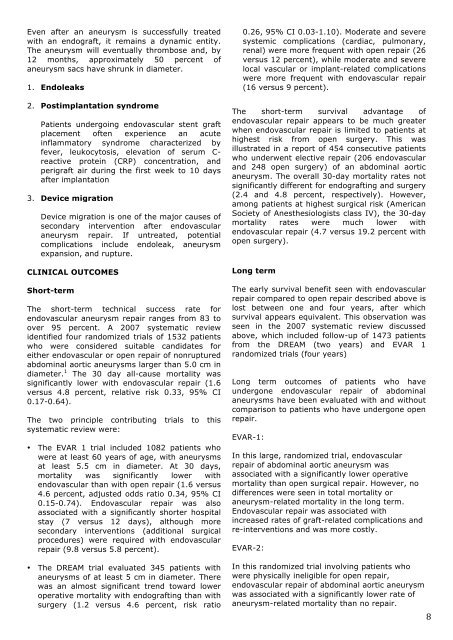January/February 2011 - SASSiT
January/February 2011 - SASSiT
January/February 2011 - SASSiT
- TAGS
- sassit
- www.sassit.co.za
Create successful ePaper yourself
Turn your PDF publications into a flip-book with our unique Google optimized e-Paper software.
Even after an aneurysm is successfully treated<br />
with an endograft, it remains a dynamic entity.<br />
The aneurysm will eventually thrombose and, by<br />
12 months, approximately 50 percent of<br />
aneurysm sacs have shrunk in diameter.<br />
1. Endoleaks<br />
2. Postimplantation syndrome<br />
Patients undergoing endovascular stent graft<br />
placement often experience an acute<br />
inflammatory syndrome characterized by<br />
fever, leukocytosis, elevation of serum Creactive<br />
protein (CRP) concentration, and<br />
perigraft air during the first week to 10 days<br />
after implantation<br />
3. Device migration<br />
Device migration is one of the major causes of<br />
secondary intervention after endovascular<br />
aneurysm repair. If untreated, potential<br />
complications include endoleak, aneurysm<br />
expansion, and rupture.<br />
CLINICAL OUTCOMES<br />
Short-term<br />
The short-term technical success rate for<br />
endovascular aneurysm repair ranges from 83 to<br />
over 95 percent. A 2007 systematic review<br />
identified four randomized trials of 1532 patients<br />
who were considered suitable candidates for<br />
either endovascular or open repair of nonruptured<br />
abdominal aortic aneurysms larger than 5.0 cm in<br />
diameter. 1 The 30 day all-cause mortality was<br />
significantly lower with endovascular repair (1.6<br />
versus 4.8 percent, relative risk 0.33, 95% CI<br />
0.17-0.64).<br />
The two principle contributing trials to this<br />
systematic review were:<br />
• The EVAR 1 trial included 1082 patients who<br />
were at least 60 years of age, with aneurysms<br />
at least 5.5 cm in diameter. At 30 days,<br />
mortality was significantly lower with<br />
endovascular than with open repair (1.6 versus<br />
4.6 percent, adjusted odds ratio 0.34, 95% CI<br />
0.15-0.74). Endovascular repair was also<br />
associated with a significantly shorter hospital<br />
stay (7 versus 12 days), although more<br />
secondary interventions (additional surgical<br />
procedures) were required with endovascular<br />
repair (9.8 versus 5.8 percent).<br />
• The DREAM trial evaluated 345 patients with<br />
aneurysms of at least 5 cm in diameter. There<br />
was an almost significant trend toward lower<br />
operative mortality with endografting than with<br />
surgery (1.2 versus 4.6 percent, risk ratio<br />
0.26, 95% CI 0.03-1.10). Moderate and severe<br />
systemic complications (cardiac, pulmonary,<br />
renal) were more frequent with open repair (26<br />
versus 12 percent), while moderate and severe<br />
local vascular or implant-related complications<br />
were more frequent with endovascular repair<br />
(16 versus 9 percent).<br />
The short-term survival advantage of<br />
endovascular repair appears to be much greater<br />
when endovascular repair is limited to patients at<br />
highest risk from open surgery. This was<br />
illustrated in a report of 454 consecutive patients<br />
who underwent elective repair (206 endovascular<br />
and 248 open surgery) of an abdominal aortic<br />
aneurysm. The overall 30-day mortality rates not<br />
significantly different for endografting and surgery<br />
(2.4 and 4.8 percent, respectively). However,<br />
among patients at highest surgical risk (American<br />
Society of Anesthesiologists class IV), the 30-day<br />
mortality rates were much lower with<br />
endovascular repair (4.7 versus 19.2 percent with<br />
open surgery).<br />
Long term<br />
The early survival benefit seen with endovascular<br />
repair compared to open repair described above is<br />
lost between one and four years, after which<br />
survival appears equivalent. This observation was<br />
seen in the 2007 systematic review discussed<br />
above, which included follow-up of 1473 patients<br />
from the DREAM (two years) and EVAR 1<br />
randomized trials (four years)<br />
Long term outcomes of patients who have<br />
undergone endovascular repair of abdominal<br />
aneurysms have been evaluated with and without<br />
comparison to patients who have undergone open<br />
repair.<br />
EVAR-1:<br />
In this large, randomized trial, endovascular<br />
repair of abdominal aortic aneurysm was<br />
associated with a significantly lower operative<br />
mortality than open surgical repair. However, no<br />
differences were seen in total mortality or<br />
aneurysm-related mortality in the long term.<br />
Endovascular repair was associated with<br />
increased rates of graft-related complications and<br />
re-interventions and was more costly.<br />
EVAR-2:<br />
In this randomized trial involving patients who<br />
were physically ineligible for open repair,<br />
endovascular repair of abdominal aortic aneurysm<br />
was associated with a significantly lower rate of<br />
aneurysm-related mortality than no repair.<br />
8

















